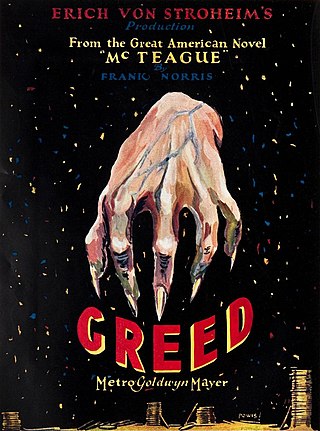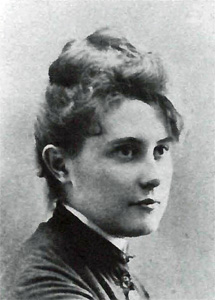Related Research Articles

Greed is a 1924 American silent psychological drama film written and directed by Erich von Stroheim and based on the 1899 Frank Norris novel McTeague. It stars Gibson Gowland as Dr. John McTeague; ZaSu Pitts as Trina Sieppe, his wife; and Jean Hersholt as McTeague's friend and eventual enemy Marcus Schouler. The film tells the story of McTeague, a San Francisco dentist, who marries his best friend Schouler's girlfriend Trina.

Erich Oswald Hans Carl Maria von Stroheim was an Austrian-American director, screenwriter, actor, and producer, most noted as a film star and avant-garde, visionary director of the silent era. His 1924 film Greed is considered one of the finest and most important films ever made. After clashes with Hollywood studio bosses over budget and workers' rights problems, Stroheim found it difficult to find work as a director and subsequently became a well-respected character actor, particularly in French cinema.
Amerigo may refer to:

Herbert Brenon was an Irish-born U.S. film director, actor and screenwriter during the era of silent films through 1940.

Henry Philmore "Harry" Langdon was an American comedian who appeared in vaudeville, silent films, and talkies.

James Wesley Horne was an American actor, screenwriter, and film director.

Frank Wright Tuttle was a Hollywood film director and writer who directed films from 1922 to 1959.

Arthur Edeson, A.S.C. was an American cinematographer. Born in New York City, his career ran from the formative years of the film industry in New York, through the silent era in Hollywood, and the sound era there in the 1930s and 1940s. His work included many landmarks in film history, including The Thief of Bagdad (1924), All Quiet on the Western Front (1930), Frankenstein (1931), The Maltese Falcon (1941), and Casablanca (1942).

George Fitzmaurice was a French-born film director and producer.
Arthur Crabtree was a British cinematographer and film director. He directed films with comedians such as Will Hay, the Crazy Gang and Arthur Askey and several of the Gainsborough melodramas.

Louis Monta Bell was an American film director, producer, and screenwriter.

Merry-Go-Round is a 1923 American feature film directed by Erich von Stroheim (uncredited) and Rupert Julian, starring Norman Kerry and Mary Philbin, and released by Universal Pictures. A copy of the film is held in a collection and it has been released on DVD.
Samuel Sax was an American film producer. He produced 80 films between 1925 and 1946, including the last films of Roscoe Arbuckle. From 1938 to 1941, Sax headed Warner Brothers's British subsidiary at Teddington Studios in London.
The Wrong Mr. Perkins is a 1931 British short comedy film directed by Arthur Varney and starring Herbert Mundin, John Stuart and Frederick Volpe. The screenplay concerns an impoverished man, Jimmy Perkins, who is mistaken by a banker for a wealthy man with a similar name.

Lucien Andriot ASC was a French and American cinematographer. He shot more than 200 films and television programs over the course of his career.
Almost a Divorce is a 1931 British comedy film directed by Jack Raymond and Arthur Varney and starring Nelson Keys, Sydney Howard and Margery Binner. It was made at British and Dominion's Elstree Studios.
Get That Venus is a 1933 American comedy film directed by Arthur Varney and starring Ernest Truex, Jean Arthur and Harry Davenport.
The Eternal Feminine is a 1931 British drama film directed by Arthur Varney and starring Guy Newall, Doria March and Jill Esmond. It was made at Twickenham Studios. Its title refers to the psychological archetype of the eternal feminine.

Luella A. Varney Serrao was an American sculptor. She was known for her portraits of notable Americans.

Sylvia of the Secret Service is a 1917 American silent thriller film directed by George Fitzmaurice and starring Irene Castle, J.H. Gilmour and Elliott Dexter. Erich von Stroheim worked as assistant director and technical advisor as well as playing the role of the villain. It was given a second release in 1922.